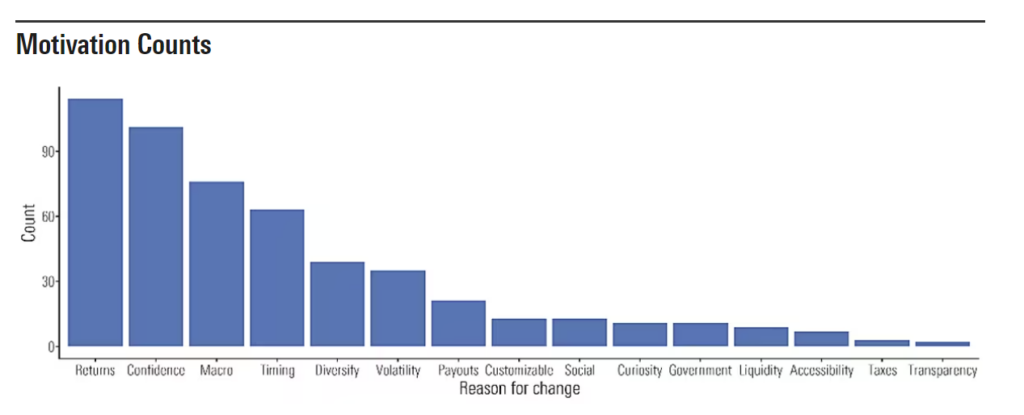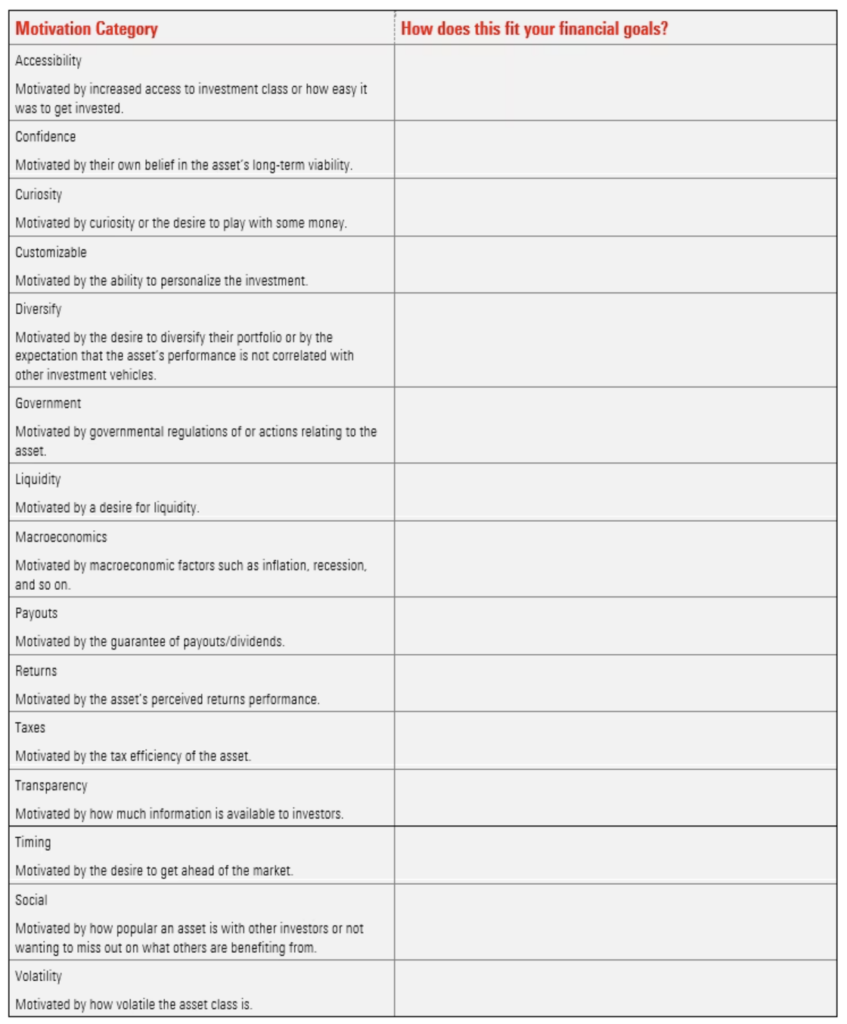Crypto, REITs, Private Equity: Long-Term Investments or Short-Term Trends?
By Samantha Lamas, Senior Behavioural Researcher
Investing trends are hard to ignore. Every swipe on your phone seems to boast a new (or reoccurring) investing opportunity that you must jump on—whether it’s a new crypto product or exposure to private equity.
The source may even provide valid-sounding reasons as to why the opportunity is a good idea. However, before you jump on the bandwagon, it’s worthwhile to consider if this opportunity is right for you, regardless of the overall benefits touted online.
Taking a step back before making the plunge can help you do two things in particular: make sure you’re not deceiving yourself and make sure your actions are in line with your financial goals.
Why Are Investors Drawn to New Investment Trends?
In our recent research, we asked individual investors about their knowledge of certain trending investments, whether they owned them, whether they were planning on changing their investment in each, and their motivations behind that decision. We focused on the following trends:
- business development companies, or BDCs
- commodities
- cryptocurrency
- private credit
- private equity
- REITs
- semiliquid interval funds
- separately managed accounts via direct indexing
- structured products
This is, of course, not an exhaustive or perfect list of all assets that could be considered “trending investments,” but it covers the main assets that we identified from conversations with industry leaders and reviews of industry research and content.
We found that most investors only had a basic understanding of these investing trends. For most of the assets, fewer than half of investors felt they could even pick out the correct definition from a list.
When we looked at people’s motivations for making changes to their future investments in each asset, the most common reasons people gave had to do with returns, their confidence in the long-term viability of the asset, macroeconomic factors they thought could affect the asset, and their desire to time the market.
Notice how most of these reasons are related to short-term thinking, trying to time the market, overemphasis on present-day returns, and overreaction to events—common mistakes investors have always made.

Furthermore, many of the benefits commonly attributed to these investing trends—things like diversification, tax efficiencies, or transparency of information—aren’t at the forefront of investors’ minds. In other words, when it comes to decisions about trending investments, it’s all too easy to fall into age-old investing pitfalls.
Follow These 3 Steps Before Jumping Into Investing Trends
To avoid making an impromptu investment decision, it’s helpful to have a set process you can use to slow down, combat cognitive biases, and think carefully through future investments.
To that end, we created a three-step process inspired by our research. The process guides investors through recognizing their knowledge level regarding the investment topic in question, addressing their motivations and connecting those back to their financial goals, and then widening their perspectives:
1. Level-set: Use the following scale to understand how knowledgeable you are about the investment topic. If you rate yourself as 3 or below, hold off on making any decisions until you more fully understand the investment. Regardless of where you are on the scale, consider visiting a few trusted sources for more information about the investment.
Knowledge Level

2. State your motivations and align with your investing goals: Take a moment to state your motivations for making this investment decision. Consider choosing from the following motivations we found in our research. Carefully consider what is driving you to make this change to your investments. Next, consider if this motivation aligns with your financial goals. Fill in the corresponding area in column two with your explanation of how this gets you closer to your long-term goals.
Motivation

3. Deliberately broaden your perspective: Because of the way our minds work, this is harder than it seems. Set aside an hour and intentionally search online for three resources that disagree with your investment decision. For example, if you are looking to buy a particular REIT, read three resources that claim this is a bad idea. Finding and considering perspectives different from your own will help you reduce confirmation bias and garner a more well-rounded view.
Since its original publication, this piece may have been edited to reflect the regulatory requirements of regions outside of the country it was originally published in. This document is issued by Morningstar Investment Management Australia Limited (ABN 54 071 808 501, AFS Licence No. 228986) (‘Morningstar’). Morningstar is the Responsible Entity and issuer of interests in the Morningstar investment funds referred to in this report. © Copyright of this document is owned by Morningstar and any related bodies corporate that are involved in the document’s creation. As such the document, or any part of it, should not be copied, reproduced, scanned or embodied in any other document or distributed to another party without the prior written consent of Morningstar. The information provided is for general use only. In compiling this document, Morningstar has relied on information and data supplied by third parties including information providers (such as Standard and Poor’s, MSCI, Barclays, FTSE). Whilst all reasonable care has been taken to ensure the accuracy of information provided, neither Morningstar nor its third parties accept responsibility for any inaccuracy or for investment decisions or any other actions taken by any person on the basis or context of the information included. Past performance is not a reliable indicator of future performance. Morningstar does not guarantee the performance of any investment or the return of capital. Morningstar warns that (a) Morningstar has not considered any individual person’s objectives, financial situation or particular needs, and (b) individuals should seek advice and consider whether the advice is appropriate in light of their goals, objectives and current situation. Refer to our Financial Services Guide (FSG) for more information at morningstarinvestments.com.au/fsg. Before making any decision about whether to invest in a financial product, individuals should obtain and consider the disclosure document. For a copy of the relevant disclosure document, please contact our Adviser Solutions Team on 02 9276 4550.
How we look after your savings
- A key focus on risk management, not just the potential for returns
- Increasing your buying power
- Today’s best investment opportunities













